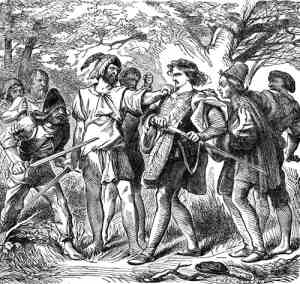Elizabethan Crime
By the time of the reign of Elizabeth 1
from 1558 to 1603 Eastern Essex had become an important area of
Essex. During this age Bradwell Juxta Mere ( Bradwell on Sea) and
Burnham on Crouch/Creeksea were important settlements.
Although life was hard for
common people, centring on agriculture or the sea, behaviour
standards were at times quite extrovert even by modern standards.
Civil and Church Courts
operated to consider both civil and moral crimes.
Sedition
Inciting disaffection towards
Elizabeth 1 was a crime that was often dealt with by the Civil
Courts. Those guilty faced punishment from public pillory to hanging
drawing and quartering. Essex saw many cases of sedition although
most cases in the Dengie were caused by over indulgence of alcohol
rather than plotting against the crown.
An example of sedition in
Dengie occurred in 1592. Randal Duckworth who was a labourer living
at Bradwell on Sea held a conversation with the Rector John Debanck
during which he complained about the government and expressed the
belief that if the Queen died the situation would improve by a
return of catholic rule. The rash words were reported and Duckworth
was sentences to stand in the pillories.
Piracy
The lack of a large navy
compared to the volume of maritime use gave rise to occasional
piracy. One of the most famous pirates during the reign of Elizabeth
1 was Fiddler the pirate.
After a successful career
Fiddler was captured by the authorities whilst staying at the White
Hart, Burnham. He was later executed and hung in chains at land now
known as Fiddlers Point, Greenhithe.
Poaching
During Elizabethan times the
area abounded in animal life including deer.
Given the poor standard of
living it was not surprising that many people appeared before the
courts for poaching.
Poachers were willing to
travel comparatively long distances to get the opportunity to poach
In 1568 an unknown Woodham
Walter Man, whose occupation was a tailor, was charged with
possession of nets and traps to poach hares.
In 1587 John Foster of Hockley
was responsible for taking 6 partridges at Asheldham
In 1581 John Johnson and Rooke
Songer from Witham traveled to Creeksea with two dogs and were
charged with coursing and killing deer at the Creeksea Place home of
local JP Arthur Harris.
Highway Robbery
The most celebrated Essex
highway robber, Dick Turpin was not born until 1706 well after the
end of the Elizabethan era the art of Highway Robbery was still
found in Essex.
Only three cases of Highway
Robbery were brought to Essex Assizes.
December 1569 A tinker from
Heybridge and a weaver from Maldon held up a man at Purleigh and
stole the considerable sum of 7 shillings. The waver was found not
guilty but the tinker paid with his life.
In 1596 a man walking on a
footpath at Stow Maries was robbed of 3 shillings 4 pence although
his assailant was found guilty of assault only.
In December 1696 at
Latchingdon a man was robed of £10 5 shillings and three pence by
three men from Blackmore. Once escaped custody and was never traced
although his two companions were hanged for their crime.

Theft Of Livestock
The coastal marshland and
extensive common land meant that the Dengie 100 teemed with
livestock especially sheep.
Theft of livestock became a
real problem with thieves stealing sheep to establish or increase
their flock.
In 1585 a Latchingdon man
traveled 25 miles to Margaret Roothing where he broke into a field
and stole 37 sheep and 25 lambs.
Six years later a Prittlewell
labourer traveled to North Fambridge Hall where he stole 28 sheep
and 26 lambs.
Horses were also common and
subject of theft. In 1572 John Hayward stole several horses and
stole some clothes from Southminster and a purse from Bradwell Juxta
Mere. Two years later he stole a horse from nearby East Hanningfield
and was hanged for his crimes.
Marriage
William Walford became
betrothed to a Creeksea woman in 1598 and appeared before the Church
Court for not marrying her despite the passage of several months
since the third reading of the banns. His explanation was that he
intended to marry the lady but stated that she was not sound in body
nor hath any hair on her head and so he did not wish to marry. The
Judge was sympathetic and accepted this as a lawful impediment to
marriage.
In 1566 Richard Nycholas of
Purleigh was charged with absenting himself from his wife. At Court
he asserted that she was not a woman lawful for a mans use. the
judge ordered that the woman be searched by women who adjudged that
she was not in fact a woman i.e. a man.
Husband/ Wife Murder,
assault, cuckolding and seduction
In the late 1500's two cases
occurred at Burnham that would have excited the interest of modern
day tabloid newspapers.
In 1582 Dorothy Clarke was a
spinster residing at Burnham. On her way to the market at Maldon she
met up with John Fletcher from Coggeshall who told her that he was a
bachelor. Although at first Dorothy rebuffed Fletcher she was
eventually won over by the promise of a chamber in London and an
allowance of 20 marks per year. On lady day which was the last day
of Maldon Fair she finally consented at the Saracens Head Inn.
Fletcher departed promising to meet Dorothy at the Cock Inn at
Boreham where he would carry her to her new chamber at London. The
appointment was not kept and so she went to find Fletcher at
Coggeshall. On the way she met Fletcher who ignored her and made
off. Dorothy then stayed at an alehouse in Coggeshall only to find
that a Coggeshall girl Susan Baybe was pregnant having admitted pre
marital sex with her half brother, Fletcher and another man.
The affair of the Burnham
Horns caused much scandal in 1584. Traditionally adorning the outer
door of a house with horns told the man of the house that he was
being cuckolded.
Robert Gybbyns a tailor from
Bradwell quarrelled with a Mr Kempe who lived at Burnham. As a
result Gybbyns and five friends walked to Burnham where they erected
horns on the door of Kempes house. The act was accompanied by so
much mirth that neighbours were awakened and saw the men and the
horns which led to much jeering.
Gybbyns appeared before the
magistrate who heard evidence of Gybbyns boast about paling the
horns from Agnes Moore who was a servant of Kempe to the effect
that Gybbyns had admited being responsible to a Mrs Philpott . When
called to give evidence Mrs Phillpot said that she saw the act but
did not know the men however the Magistrate was satisfied at the
guilt of Gybbyns who he said has caused great offence to the
neighbours and to the cuckolded men and their wives.
An even worse tale occurred in
1590 when John Chaundler began an affair with a Mrs Phillpott.
Chaundler approached Rowland Griffyth who agreed to murder Mr
Phillpot so that Chaundler could have Phillpots wife and his goods.
The plot was discovered and Gryffyth turned Queens evidence.
Chaundler fled and Mrs Phillpott took to her sick bed so that the
case was adjourned and nothing further heard.
Sexual Offences
Incest was a crime in the eyes
of the church although not in the state. Incest was proved by
persons cohabiting with any physical relationship proved.
Despite this many marriages of
first cousins and even closer relations were at times permitted.
One case involving Anthony
Walkers admission of incestuous intercourse with Margaret Younge was
dealt with by means of public confession in Burnham Parish Church
and regular religious instruction by the Curate
Masters were not supposed to
take advantage of their servants as a Cold Norton man found in 1583
when he was found guilty of immorality with his servant. He was told
to show that he was heartily sorry in live more circumspectly
hereafter and was made to give to the Parishioners a Book of Martyrs
and to pay 20shillings for the use of poor scholars
Church offences
During Elizabethan times some
members of the Clergy behaved in an ungodly manner which caused them
problems with the emerging puritanical preachers.
Thomas Howell the Rector of
nearby Pagglesham appeared before the Church Court in 1587 after
brawling in Burnham Parish Church with the Curate William Chase.
The Court were told that Rector Howell had recently been suspended
for a previous offence and lost his benefice.
In the following year the new
Curate of Burnham was Thomas Stempe who appeared before the Court
charged with frequenting an alehouse and thus holding no service on
Sunday afternoon. For this Stempe was made to do penance. The lesson
did not seem to be learnt as Stempe later appeared before the
criminal court in 1596 for attempted rape.
Parishioners could also fall
foul of Church Courts when bell ringers at Purleigh, Dengie and
Woodham Mortimer were censured for ringing the church bells at
Halloween a practice forbidden in the Anglican Church after the
reformation.
Witches
Many people were accused of
being witches for which the were tried at witch trials. Some were
found innocent but many were hanged or died in prison.
Click here for a special page on this website dealing with witchcraft.



